Element contents
Civil-Military Relations in Southeast Asia
Published online by Cambridge University Press: 05 September 2018
Summary
- Type
- Element
- Information
- Online ISBN: 9781108654715Publisher: Cambridge University PressPrint publication: 30 August 2018
References
- 23
- Cited by



